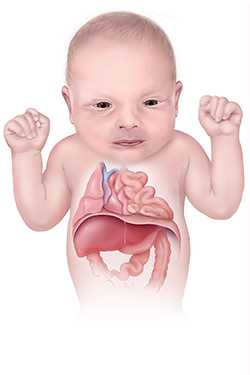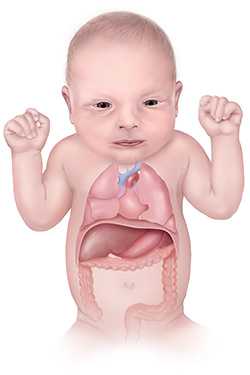Facts about Diaphragmatic Hernia
Diaphragmatic hernia is a birth defect where there is a hole in the diaphragm.
What is Diaphragmatic Hernia?
Diaphragmatic hernia is a birth defect where there is a hole in the diaphragm (the large muscle that separates the chest from the abdomen). Organs in the abdomen (such as intestines, stomach, and liver) can move through the hole in the diaphragm and upwards into a baby’s chest. When an organ pushes through the hole, it is called a hernia. A diaphragmatic hernia can prevent the baby’s lungs from developing completely, causing breathing difficulties for the baby at birth.
Occurrence
Researchers do not know exactly how many babies are affected by diaphragmatic hernia each year. However, one study estimated that about 1 in 4,000 babies are born with a diaphragmatic hernia every year.1 About half of all newborns who have diaphragmatic hernia also have other conditions, including birth defects of the brain, heart, and intestines.2
Causes and Risk Factors
While the causes of diaphragmatic hernia in most infants are unknown, researchers believe that some instances of diaphragmatic hernia may be caused by abnormalities in the baby’s genes.
Understanding the factors that are more common among babies with a birth defect will help us learn more about the causes. CDC funds the Centers for Birth Defects Research and Prevention, which collaborates on large studies, such as the National Birth Defects Prevention Study (NBDPS; births 1997-2011) and the Birth Defects Study to Evaluate Pregnancy exposureS (BD-STEPS; began with births in 2014), to understand the causes of and risks for birth defects, such as diaphragmatic hernia.
If you are pregnant or thinking about becoming pregnant, talk with your doctor about ways to increase your chances of having a healthy baby.
Diagnosis
During pregnancy, there are screening tests to check for some birth defects and other conditions. Doctors can usually diagnose diaphragmatic hernia before the baby is born. Doctors use an ultrasound to create a picture of the diaphragm and lungs to look for abnormalities.
In some cases, ultrasounds during pregnancy do not show the diaphragmatic hernia. However, once the baby is born, doctors may diagnose the condition after noticing that the baby has trouble breathing. A chest x-ray can show that organs normally in the abdomen are in the chest, and the lungs look smaller than normal or are pushed to one side.
Management and Treatment
Surgery is necessary to repair a diaphragmatic hernia soon after the baby is born. After surgery, the baby will need continued assistance to breathe until the lungs recover and expand.
References
- Skari H, Bjornland K, Haugen G, Egeland T, Emblem R. Congenital diaphragmatic hernia: a meta-analysis of mortality factors. J Pediatr Surg. 2000; 35:1187–1197.
- Pober BR, Russell MK, Ackerman KG. Congenital Diaphragmatic Hernia Overview. 2006 Feb 1 [Updated 2010 Mar 16]. In: Pagon RA, Adam MP, Ardinger HH, et al., editors. GeneReviews® [Internet]. Seattle (WA): University of Washington, Seattle; 1993-2016. Available from: http://www.ncbi.nlm.nih.gov/books/NBK1359/
- Page last reviewed: May 12, 2017
- Page last updated: May 12, 2017
- Content source:



 ShareCompartir
ShareCompartir


